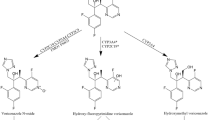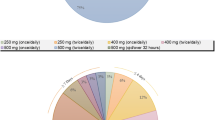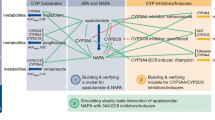Abstract
The aim of the study was to assess the magnitude of the CYP3A4 inhibitory effect of 2 dosing regimens of ketoconazole and the influence of the pharmacokinetic properties of the CYP3A4 substrate on the extent of the substrate exposure increase. For this purpose, a clinical study was conducted and PBPK modeling simulations were performed. A crossover study was conducted in healthy subjects. The study was designed to compare the effects of different regimens of reversible CYP3A4 inhibitors, i.e., ketoconazole 400 mg OD, ketoconazole 200 mg BID, on two CYP3A4 substrates, alprazolam and midazolam, reflecting different pharmacokinetic properties in terms of first-pass effect and elimination. In parallel, time-based simulations were performed using the Simcyp population-based Simulator to address the usefulness of modeling to assess interaction clinical study design with CYP3A4 substrates. Comparison of the OD versus BID regimens for ketoconazole showed an opposite trend for the 2 substrates: BID (200 mg) dosing regimen provided the maximal clearance inhibition for alprazolam, while it was OD (400 mg) dosing regimen for midazolam. However, these effects are moderate despite the well-known pharmacokinetic differences between these substrates, suggesting that these differences are not enough. In the other way round, these investigations show how two CYP3A4 substrates can be different without leading to a major impact of the ketoconazole dosing regimen. The clinical findings are consistent with the Simcyp predictions, in particular the opposite trend observed with midazolam and alprazolam and the ketoconazole dosing regimen. These clinical investigations showed the influence of the CYP3A4 substrates’ pharmacokinetic properties and the relevance of ketoconazole dose regimen on the magnitude of the interaction ratios. In addition, PBPK Simcyp simulations demonstrated how they can be used to help clinical study design assessment to capture the maximum effect.




Similar content being viewed by others
References
Bjornsson TD, Callaghan JT, Einolf HJ, Fischer V, Gan L, Grimm S et al (2003) The conduct of in vitro and in vivo drug–drug interaction studies: a Pharmaceutical Research and Manufacturers of America (PhRMA) perspective. Drug Metab Dispos 31(7):815–832
Boulenc X, Barberan O (2011) Metabolic-based drug–drug interactions prediction, recent approaches for risk assessment along drug development. Drug Metabol Drug Interact 26(4):147–168
Brown HS, Ito K, Galetin A, Houston JB (2005) Prediction of in vivo drug–drug interactions from in vitro data: impact of incorporating parallel pathways of drug elimination and inhibitor absorption rate constant. Br J Pharmacol 60(5):508–518
Djebli N, Rauch C, Fabre D, Boulenc X (2009) Quantification of the pharmacokinetic inhibition of a CYP3A4/CYP2D6 substrate with low hepatic first pass effect and long terminal half-life; importance of study design and inhibition mechanism: a simulation study. Global Metabolism and Pharmacokinetics, Poster at ISSX meeting, Baltimore, USA
European Medicines Agency Guideline on the Investigation of Drug Interactions (2012) Committee for human medicinal products (CHMP). http://www.ema.europa.eu/docs/en_GB/document_library/Scientific_guideline/2012/07/WC500129606.pdf. Accessed 4 July 2013
Grenblatt DJ, Wright CE, von Moltke LL, Harmatz JS, Ehrenberg BL, Harrel LM et al (1998) Ketoconazole inhibition of triazolam and alprazolam clearance: differential kinetic and dynamic consequences. Clin Pharmacol Ther 64(3):237–247
Guest EJ, Rowland-Yeo K, Rostami-Hodjegan A, Tucker GT, Houston JB, Galetin A (2011) Assessment of algorithms for predicting drug–drug interaction via inhibition mechanisms: comparison of dynamic and static models. Br J Clin Pharmacol 71:72–87
Guidance for Industry (2012) Drug Interaction Studies—Study Design, Data Analysis, Implications for Dosing, and Labeling Recommendations. Food and Drug Administration, Center for Drug Evaluation and Research (CDER). http://www.fda.gov/Drugs/GuidanceComplianceRegulatoryInformation/Guidances/default.htm
Jamei M, Marciniack S, Feng K, Barnett A, Tucker G, Rostani-Hodjegan A (2009) The Simcyp population—based ADME simulator. Expert Opin Metab Drug Toxicol. 5:211–223
Masica AL, Mayo G, Wilkinson GR (2004) In vivo comparisons of constitutive cytochrome P450 3A activity assessed by alprazolam, triazolam, and midazolam. Clin Pharmacol Ther 76(4):341–349
Obach RS, Walsky RL, Venkatakrishnan K, Garman EA, Houston JB, Tremaine LM (2006) The utility of in vitro cytochrome P450 inhibition data in the prediction of drug–drug interactions. J Pharmacol Exp Ther 316(1):336–348
Olkkola KT, Backman JT, Neuvonen PJ (1994) Midazolam should be avoided in patient receiving the systemic antimycotics ketoconazole or itraconazole. Clin Pharmacol Ther 55(5):481–485
Rowland YK, Walsky RL, Jamei M, Rostani-Hodjegan A, Tucker GT (2011) Prediction of time-dependent CYP3A4 drug–drug interactions by physiologically based pharmacokinetic modelling: impact of inactivation parameters and enzyme turnover. Eur J Pharm Sci 43(3):160–173
Shimada T, Yamazaki H, Mimura M, Inui Y, Guengerich FP (1994) Interindividual variations in human liver cytochrome P-450 enzymes involved in the oxidation of drugs, carcinogens and toxic chemicals: studies with liver microsomes of 30 Japanese and 30 Caucasians. J Pharmacol Exp Ther 270(1):414–423
Stoch SA, Friedman E, Maes A, Yee K, Xu Y, Larson P et al (2009) Effect of different durations of ketoconazole dosing on the single-dose pharmacokinetics of midazolam: shortening the paradigm. J Clin Pharmacol 49:398–406
Yuan R, Flockhart DA, Balian JD (1999) Pharmacokinetic and pharmacodynamic consequences of metabolism-based drug interactions with alprazolam, midazolam, and triazolam. J Clin Pharmacol 39:1109–1125
Zhao P, Ragueneau-Majlessi I, Zhang L, Strong JM, Reynolds KS, Levy RH et al (2009) Quantitative evaluation of pharmacokinetic inhibition of CYP3A substrates by ketoconazole: a simulation study. J Clin Pharmacol 49(3):351–359
Zhou ZW, Zhou SF (2009) Expert Opin Drug Metab Toxicol 5(6):579–605
Conflict of interest
The study was exclusively sponsored by Sanofi and conducted in Eurofins Optimed under the responsibility of the sponsor, Sanofi. There are no competing interests to declare.
Author information
Authors and Affiliations
Corresponding author
Rights and permissions
About this article
Cite this article
Boulenc, X., Nicolas, O., Hermabessière, S. et al. CYP3A4-based drug–drug interaction: CYP3A4 substrates’ pharmacokinetic properties and ketoconazole dose regimen effect. Eur J Drug Metab Pharmacokinet 41, 45–54 (2016). https://doi.org/10.1007/s13318-014-0235-4
Received:
Accepted:
Published:
Issue Date:
DOI: https://doi.org/10.1007/s13318-014-0235-4




